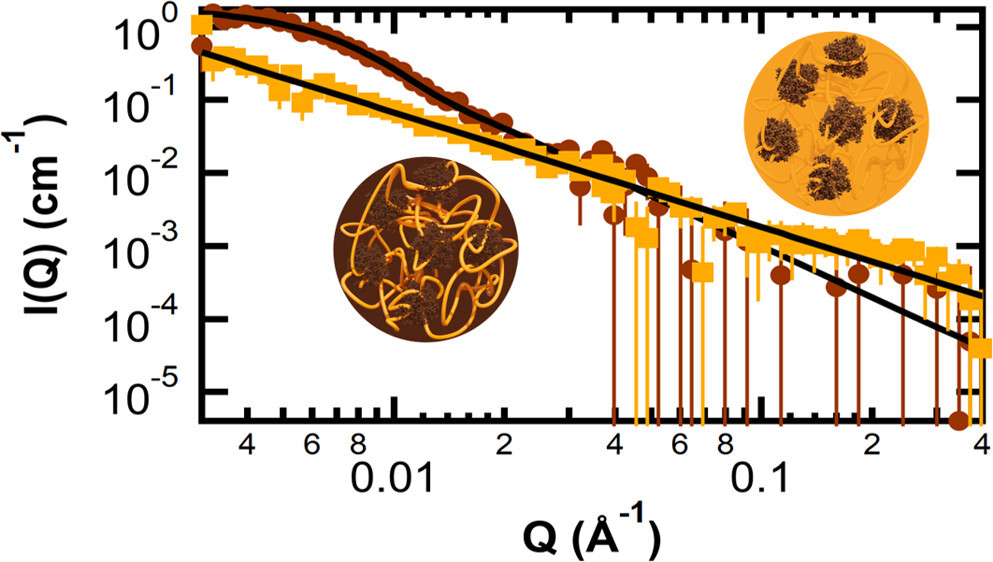Lignin−Pectin Complexation Implicated in Biomass Recalcitrance
10/23/2023

Small-Angle Neutron Scattering (SANS) of a Lignin–Carbohydrate Complex. At the contrast match point for pectin (40% D2O, brown curve), pectin recedes into the background, enabling structural analysis of lignin individually via SANS. Likewise, at the contrast match point for lignin (80% D2O, yellow curve), lignin recedes into the background. The inset schematic images represent the components visible at the different contrast match points (yellow lignin visible at left; brown pectin visible at right).
[Reprinted with permission from Shah et al. DOI:10.1021/acssuschemeng.3c04322. Copyright 2023 American Chemical Society.]
The Science
Lignin–carbohydrate complexes (LCCs) form through interactions of lignin with plant cell wall polysaccharides and are thought to be a significant source of biomass recalcitrance. Understanding LCCs and their effects on lignin morphology is needed to improve biomass conversion to biofuels and bioproducts.
The role of pectin plant cell wall recalcitrance was investigated and showed strong evidence that pectin changes how lignin distributes in plant cell walls during thermochemical pretreatment. Additional analysis of a model composite composed of pectin and lignin showed that pectin and lignin form a highly interconnected polymer network and evidence of an ester bond between the polymers.
Overall, this study provides new insights into the relationship between primary and secondary cell wall polymers during cell wall synthesis. It may help develop new approaches to modulate cell wall properties to improve biofuel and bioproduct production.
The Impact
This work shows that interactions between pectin and lignin may be a previously unidentified contributor to LCCs in plant cell walls. Engineering plants to reduce these interactions could decrease biomass recalcitrance for biofuel production.
The Summary
This work investigated LCCs formed between lignin and the pectin homogalacturonan (HG). Structural changes in HG-deficient transgenic switchgrass after hot water pretreatment were compared to wildtype plants using small-angle neutron scattering (SANS). SANS showed ~2.2-fold more lignin aggregates in the transgenic biomass compared to wildtype. This suggests that decreased pectin resulted in greater lignin redistribution to form aggregates and that interactions between lignin and HG restrict lignin mobility in plant cell walls.
To better understand the types of interactions between lignin and pectin, a model composite was prepared by polymerizing either protiated or partially deuterated coniferyl alcohol to form dehydrogenation polymer (DHP) in the presence of HG. Small-angle X-ray scattering showed that the DHP and HG form a highly interconnected network structure that is not observed in a physical mixture of the individual polymers. Contrast matching SANS revealed the structural characteristics of DHP and HG in the composite and showed that the HG forms a swollen interconnected polymer network interspersed with DHP particles that are composed of solvent-accessible DHP polymers. Fourier transform infrared spectroscopy showed a unique ester absorption band in the DHP/HG composites. Solid-state nuclear magnetic resonance (NMR) analysis also supports interactions between DHP and HG.
Funding
This work was supported by the Genomic Science Program, Biological and Environmental Research program (BER), U. S. Department of Energy (DOE), under Contract FWP ERKP752. d5-coniferyl alcohol was synthesized using the capabilities of the Center for Nanophase Materials Sciences supported by the Office of Basic Energy Sciences, DOE. Small-angle neutron scattering (SANS) studies of the DHP-pectin composites were performed using the Bio-SANS instrument of the Center for Structural Molecular Biology (FWP ERKP291) a BER Structural Biology Resource. A.K.B. was supported by the BER funded Center for Bioenergy Innovation (CBI), managed by Oak Ridge National Laboratory (ORNL). The authors thank Professor Debra Mohnen, Complex Carbohydrate Center, University of Georgia for scientific discussions and providing materials for the project. GAUT4-KD and control switchgrass samples were provided by the CBI. This research used resources at the High Flux Isotope Reactor and Spallation Neutron Source, a DOE Office of Science User Facility operated by ORNL. ORNL is operated by UT-Battelle, LLC under Contract No. DE-AC05-00OR22725 with DOE.
Related Links
References
Shah, R. S. et al. 2023. “Evidence for Lignin–Carbohydrate Complexes from Studies of Transgenic Switchgrass and a Model Lignin–Pectin Composite,” ACS Sustainable Chemistry and Engineering 11(44), 15941–50. DOI:10.1021/acssuschemeng.3c04322.
